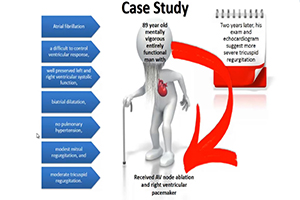Non-functional tricuspid valve disease
Abstract
Only 75% of severe tricuspid regurgitation is classified as functional, or related primarily to pulmonary hypertension, right ventricular dysfunction, or a combination of both. Non-functional tricuspid regurgitation occurs when there is damage to the tricuspid leaflets, chordae, papillary muscles, or annulus, independent of right ventricular dysfunction or pulmonary hypertension. The entities that cause non-functional tricuspid regurgitation include rheumatic and myxomatous disease, acquired and genetic connective tissue disorders, endocarditis, sarcoid, pacing, RV biopsy, blunt trauma, radiation, carcinoid, ergot alkaloids, dopamine agonists, fenfluramine, cardiac tumors, atrial fibrillation, and congenital malformations. Over time, severe tricuspid regurgitation that is initially non-functional, can blend into functional tricuspid regurgitation, related to progressive right ventricular dysfunction. Symptoms and signs, including a falling right ventricular ejection fraction, cardiac cirrhosis, ascites, esophageal varices, and anasarca, may occur insidiously and late, but are associated with substantial morbidity and mortality. Attempted valve repair or replacement at late stages carries a high mortality. Crucial to following patients with severe non-functional tricuspid regurgitation is attention to echo quantification of the tricuspid regurgitation and right ventricular function, patient symptoms, and the physical examination.
Cover






